|
|
|
Sort Order |
|
|
|
Items / Page
|
|
|
|
|
|
|
| Srl | Item |
| 1 |
ID:
137943
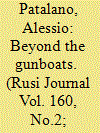

|
|
|
|
|
| Summary/Abstract |
In East Asia, the coercive use of maritime capabilities has led some to argue that the return of gunboat diplomacy has become inevitable. The use of coercion and deterrence there are indeed undeniable. However, Alessio Patalano argues that there is more than gunboats to diplomacy in a self-aware maritime East Asia. Capable navies can offer a significant contribution when dealing with major natural disasters, and these deployments should be regarded as diplomatic missions aimed at building relations and enhancing regional security. Japan's experience in this regard provides a relevant case in support of this argument.
|
|
|
|
|
|
|
|
|
|
|
|
|
|
|
|
| 2 |
ID:
133406
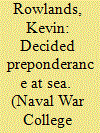

|
|
|
|
|
| Publication |
2012.
|
| Summary/Abstract |
Oliver Cromwell famously declared that "a man-o'-war is the best ambassador"; a twenty-first-century equivalent represents the U.S. Navy in posters and on T-shirts and sweatshirts as an aircraftcarrier over the caption "90,000 tons of diplomacy." Though the images may be different, the message is the same-yet "naval diplomacy" is not a readily understood term. From the coercion delivered by the gunboats of the Pax Britannica to the modern-day exercise of softpower through hardware, interpretations of what constitutes naval diplomacy are wide-ranging. Strategists have undoubtedly long been aware of its existence, but over the centuries few have been moved to study or document it in any substantial way.
|
|
|
|
|
|
|
|
|
|
|
|
|
|
|
|
| 3 |
ID:
112005
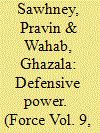

|
|
|
| 4 |
ID:
133487
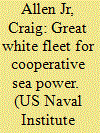

|
|
|
|
|
| Publication |
2014.
|
| Summary/Abstract |
In 1907 President Theodore Roosevelt deployed a great white fleet of 16 modern battleships around the globe to demonstrate America's arrival in the world sea-power arena. The voyage heralded America's turn to "big stick" naval diplomacy, and the fleet's com-position reflected the premium on capital ships advocated by the 20th centaury's most influential sea-power theorist, Captain Alfred Thayer Mahan.
|
|
|
|
|
|
|
|
|
|
|
|
|
|
|
|
| 5 |
ID:
007584
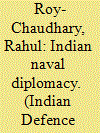

|
|
|
|
|
| Publication |
1995.
|
| Description |
53-56
|
|
|
|
|
|
|
|
|
|
|
|
|
|
|
|
| 6 |
ID:
151136
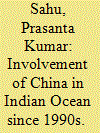

|
|
|
|
|
| Summary/Abstract |
In sum we can say that the majority of the nations are not really interested in being a part of the SOP as it is having a negative impact among the nations. But they really wanted to maintain good relations with China and India. The relations they are still continuing with China are purely business oriented. They are not only seeking assistance.
|
|
|
|
|
|
|
|
|
|
|
|
|
|
|
|
| 7 |
ID:
108890
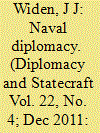

|
|
|
|
|
| Publication |
2011.
|
| Summary/Abstract |
This article considers theoretical aspects of the non-belligerent and political use of naval forces, commonly described as naval diplomacy. It presents four arguments. Firstly, it criticises the often used term "gunboat diplomacy" for being too narrow, emotionally charged, and burdened by colonialism. Secondly, the theories on naval diplomacy are criticised for being better suited for doctrinal purposes than for analytical purposes. Thirdly, criticism is levelled against the term "naval presence," which is deemed insufficient as a focal point in a theory of naval diplomacy. Fourthly, elements of a workable theory of naval diplomacy are presented, including the political aim, naval means, diplomatic method, and geopolitical context. In conclusion, warships and navies are described as symbols of national sovereignty and power, and for having, not only a defence value, but also a symbolic, supportive, and coercive value.
|
|
|
|
|
|
|
|
|
|
|
|
|
|
|
|
| 8 |
ID:
089249
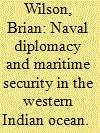

|
|
|
|
|
| Publication |
2009.
|
| Summary/Abstract |
Maritime violence off the Horn of Africa has generated immense global attention. Ships carrying cargo that included oil, military weapons, and chemicals have been attacked. More than 20,000 vessels ply this strategically important area that includes the Gulf of Aden, the Red Sea, the Arabian Sea, and the western Indian Ocean every year. To confront the threat of Somali piracy, a combination of national commitment, naval force, and international action has emerged, presaging greater partnering, utilization of the rule of law to address regional instability at sea, 'out-of-area' employment of naval forces, and the integration of international organizations to facilitate repression of maritime piracy.
|
|
|
|
|
|
|
|
|
|
|
|
|
|
|
|
| 9 |
ID:
142411
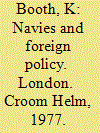

|
|
|
|
|
| Publication |
London, Croom Helm, 1977.
|
| Description |
294p.pbk
|
| Contents |
B
|
| Standard Number |
0856643238
|
|
|
|
|
|
|
|
|
|
|
|
Copies: C:1/I:0,R:0,Q:0
Circulation
| Accession# | Call# | Current Location | Status | Policy | Location |
| 058417 | 359.03/BOO 058417 | Main | On Shelf | General | |
|
|
|
|
| 10 |
ID:
108071
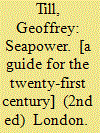

|
|
|
|
|
| Edition |
2nd ed
|
| Publication |
London, Routledge, 2009.
|
| Description |
xxi, 409p.
|
| Standard Number |
9780415480888, hbk
|
|
|
|
|
|
|
|
|
|
|
|
Copies: C:1/I:0,R:0,Q:0
Circulation
| Accession# | Call# | Current Location | Status | Policy | Location |
| 056316 | 359.03/TIL 056316 | Main | On Shelf | General | |
|
|
|
|
| 11 |
ID:
122027
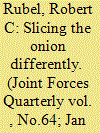

|
|
|
| 12 |
ID:
078828
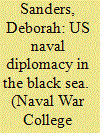

|
|
|
| 13 |
ID:
185919
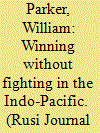

|
|
|
|
|
| Summary/Abstract |
In the essay that won the 2021 Trench Gascoigne Essay Prize (Full-Time Education Category), William Parker assesses the naval military instrument and its utility short of combat in the Indo-Pacific. By analysing the conceptual basis for the Royal Navy’s Indo-Pacific tilt, he argues that operational concepts and naval doctrine must work together in areas where, currently, they are not. He concludes that ensuring the conduct of naval diplomacy as a strategic practice, which serves the habit of statecraft, is crucial in reducing the chance of competitive peace leading to violent war.
|
|
|
|
|
|
|
|
|
|
|
|
|
|
|
|
|
|
|
|
|